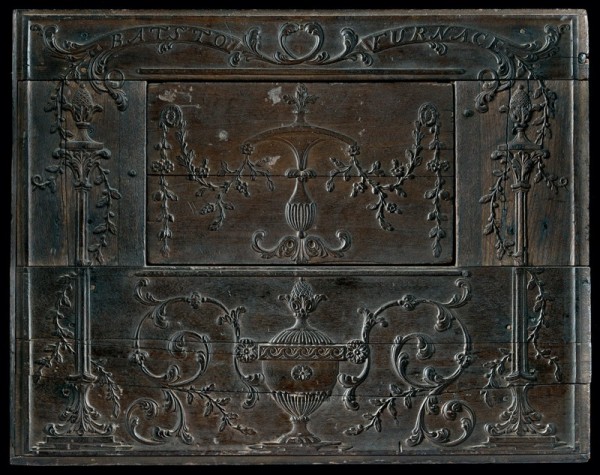
Pattern for the side plate of a six- or ten-plate stove, Batsto Furnace, Burlington County, New Jersey, 1780–1790. Mahogany with oak (battens). 26" x 33". (Courtesy, Burlington County Historical Society; photo, Gavin Ashworth.)
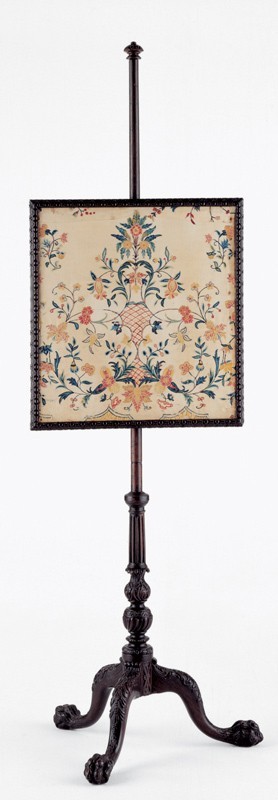
Firescreen attributed to Thomas Affleck with carving attributed to Bernard and Jugiez, Philadelphia, Pennsylvania, 1770–1775. Mahogany. H. 60 3/4". (Courtesy, Chipstone Foundation.)

Andirons, possibly Daniel King, Philadelphia, Pennsylvania, 1780–1790. Brass; wrought iron. H. 19 1/2". (Courtesy, Winterthur Museum.)
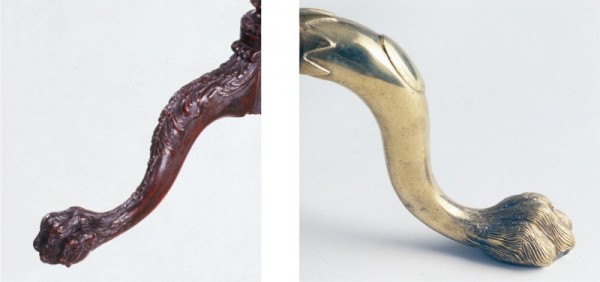
Details of a foot on the firescreen illustrated in fig. 2 and one of the andirons illustrated in fig. 3.

Chimney back, Marlboro Furnace, Frederick County, Virginia, ca. 1770. Cast iron. 34 1/2" x 31". (Courtesy, United States Army Engineer Museum, Fort Belvoir, Virginia; photo, Robert Hinds.)

Detail of A Survey of the Northern Neck of Virginia (London, 1745). (Courtesy Colonial Williamsburg Foundation.)
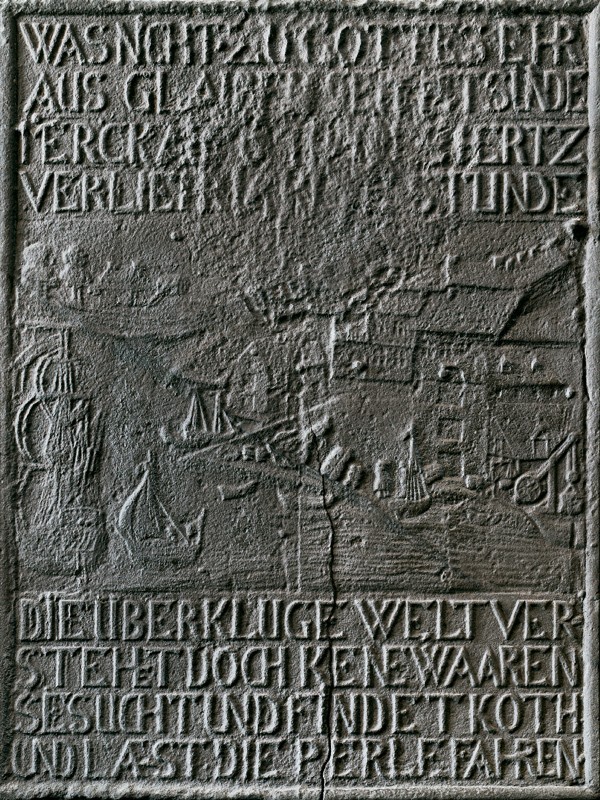
Side plate from a jamb stove, possibly Colebrookdale Furnace, Berks County, Pennsylvania, 1735–1755. Cast iron. 29" x 25". (Courtesy, Mercer Museum of the Bucks County Historical Society; photo, Gavin Ashworth.) The stove represented by this side plate may have had an end plate like the example illustrated in fig. 8.
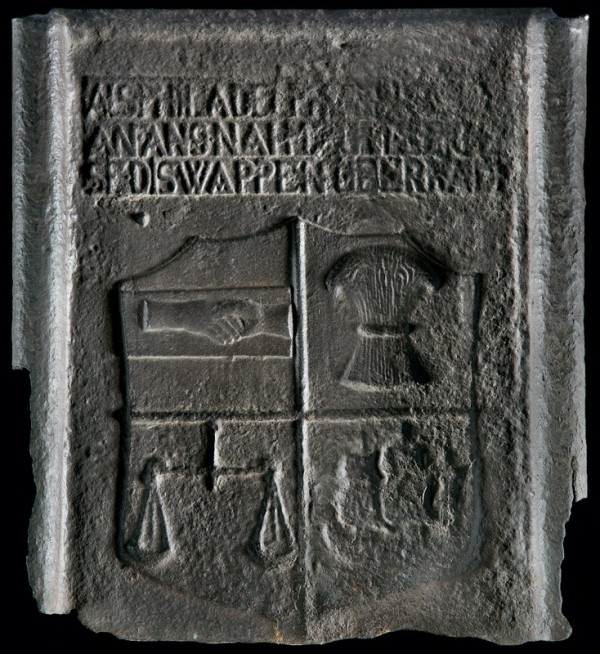
End plate from a jamb stove, possibly Colebrookdale Furnace, Berks County, Pennsylvania, 1735–1755. Cast iron. 22" x 19". (Courtesy, Mercer Museum of the Bucks County Historical Society; photo, Gavin Ashworth.) This shield design was the seal of Philadelphia after 1701.
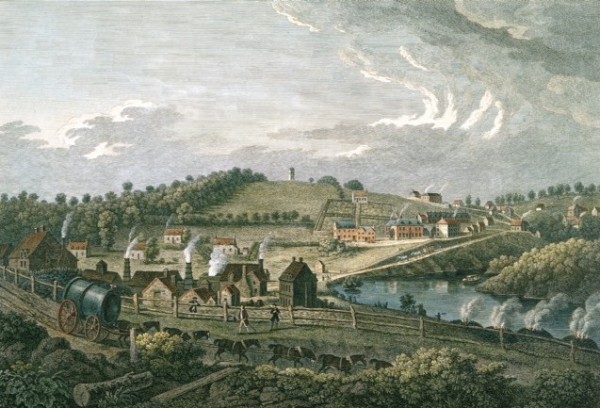
Francis Vivares after Thomas Smith of Derby, A View of the Lower Works at Coalbrookdale Furnace, 1758. Etching. 15" x 20 3/4". (Courtesy, © Trustees of the British Museum.)

Philip Loutherbourg, Coalbrookdale by Night, Shropshire, England, 1801. Oil on canvas. 26 3/4" x 42". (Courtesy, Science Museum/Science Society and Picture Library.)
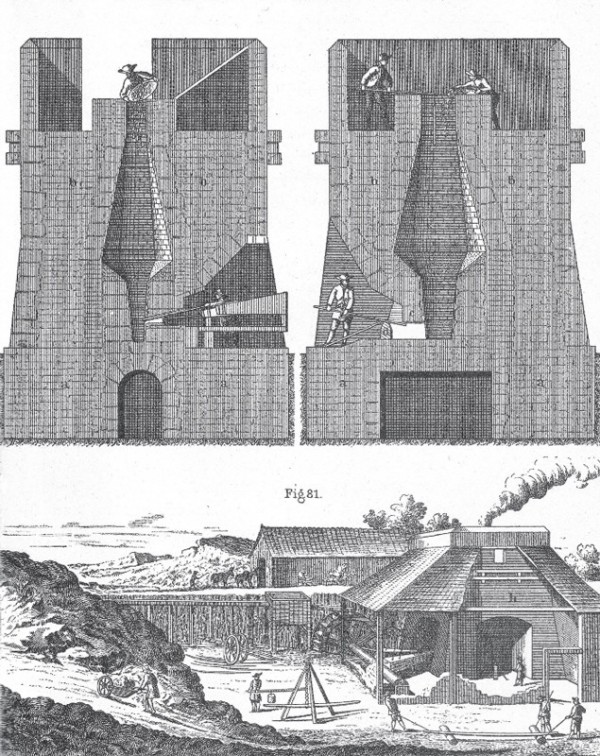
“DE LA CONSTRUCTION DES HAUTS-FOURNEAUX .” (en.wikipedia.org/wiki/Blast_furnace.)
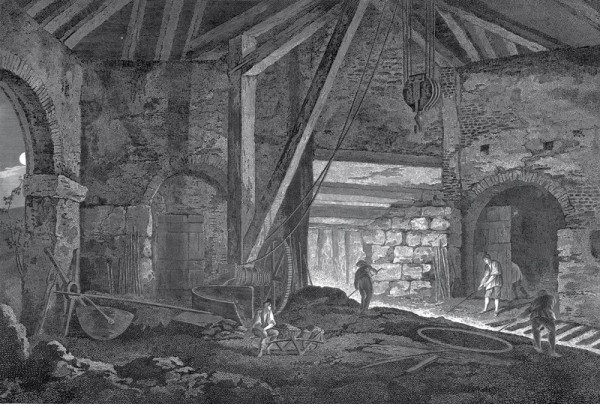
Wilson Lowry after George Robertson, Inside of a Smelting House, Coalbrookdale Furnace, Shropshire, England, 1788. Engraving. 22" x 18". (Reproduced by permission of the Ironbridge Gorge Museum Trust.)
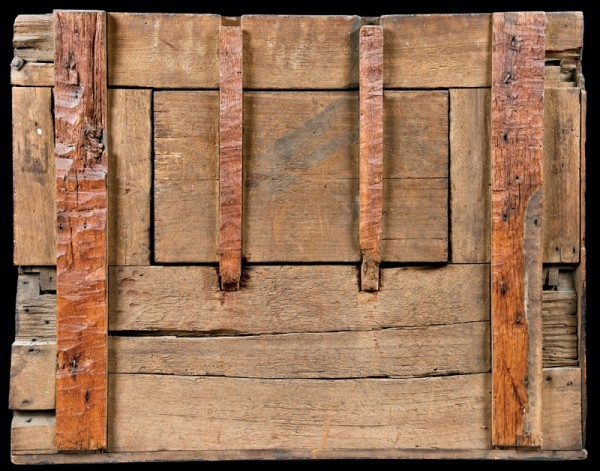
Back of the pattern illustrated in fig. 1. (Photo, Gavin Ashworth.)

Detail of a batten on the pattern illustrated in fig. 1. (Photo, Gavin Ashworth.)
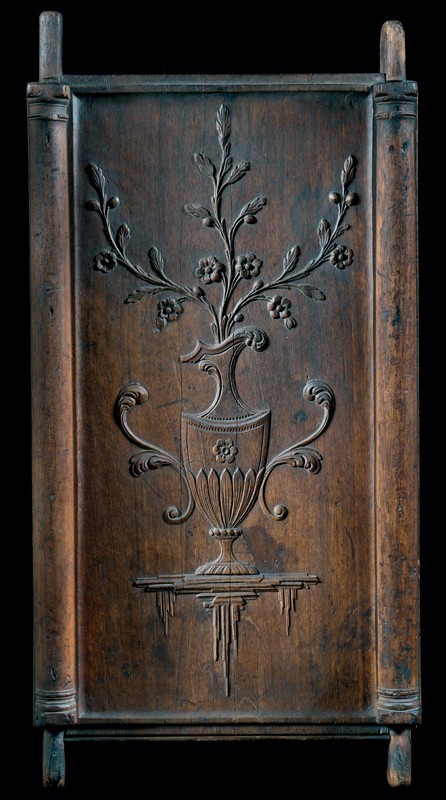
Pattern for the end plate of a stove, carving attributed to the shop of John Pollard, Philadelphia, Pennsylvania, 1775–1785. Mahogany. 26" x 15". (Courtesy, Mercer Museum of the Bucks County Historical Society; photo, Gavin Ashworth.)
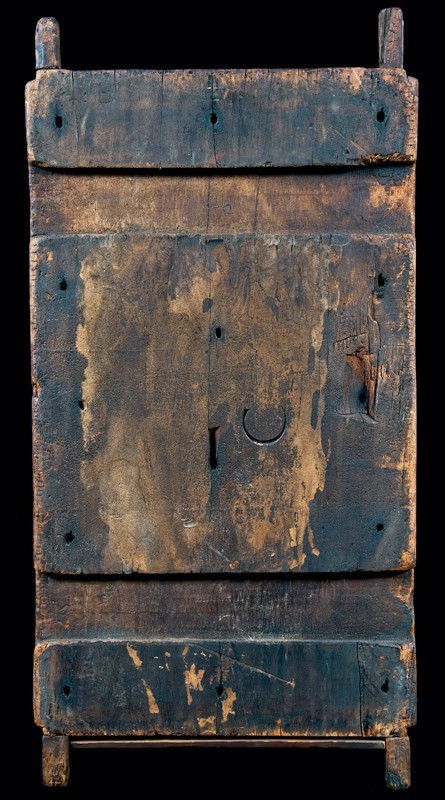
Back of the pattern illustrated in fig. 15. (Photo, Gavin Ashworth.)

Detail of the carving on the pattern illustrated in fig. 15, showing the almost perfectly flat ground. (Photo, Gavin Ashworth.)

Pier table, Philadelphia, Pennsylvania, ca. 1765. Mahogany with white oak; marble. H. 32 1/2", W. 62 3/4", D. 31 5/8". (Courtesy, Philadelphia Museum of Art; photo, Gavin Ashworth.) The pieces of figured marble veneer forming the top are bonded to a gray stone core with a roughly worked rear edge. The solid molded edges are attached to the core in a manner similar to cross-banded moldings on wooden tops. The top has a complex history of breakage and repair. Most of the veneer pieces at the ends and all of the side moldings are replaced; iron and steel splints have been added to the undersurface; and losses on the top have been filled.
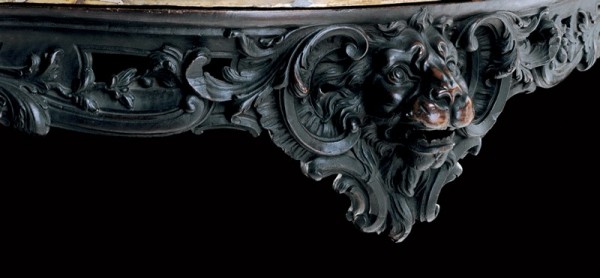
Detail of the lion’s head on the pier table illustrated in fig. 18. (Photo, Gavin Ashworth.)

Chimney back, probably Durham Furnace, Bucks County, Pennsylvania, ca. 1728. Cast iron. 27" x 18 1/2". (Courtesy, Stenton, National Society of the Colonial Dames of America in the Commonwealth of Pennsylvania; photo, Philadelphia Museum of Art.) The initials “I” and “L” were pressed into the casting sand after the pattern was removed. An identical chimney back with the same date, but without initials, has a history of use in Graeme Park.
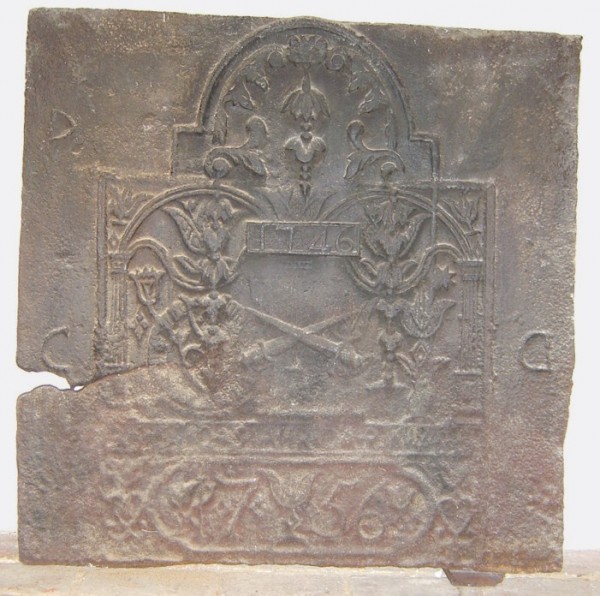
Chimney back, probably Durham Furnace, Bucks County, Pennsylvania, dated 1746 and 1756. Cast iron. 36" x 36". (Private collection.) A related chimney back with crossed swords has panels with the same dates.
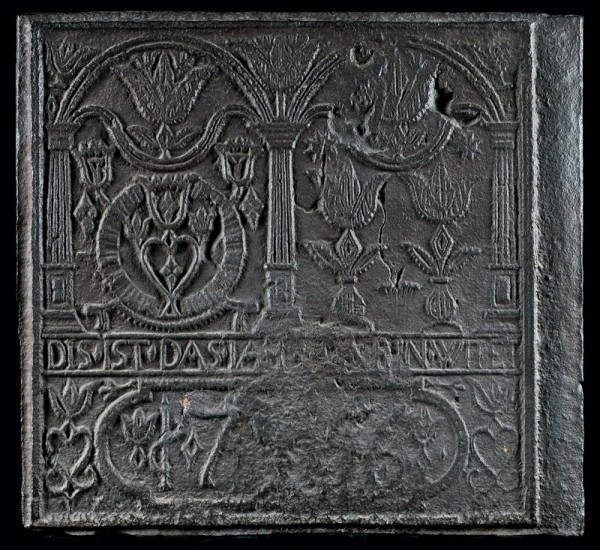
Side plate from a jamb stove, probably Durham Furnace, Bucks County, Pennsylvania, dated 1756. Cast iron. 26" x 28". (Courtesy, Mercer Museum of the Bucks County Historical Society; photo, Gavin Ashworth.) The front plate of the stove represented by this side plate is also dated 1756.
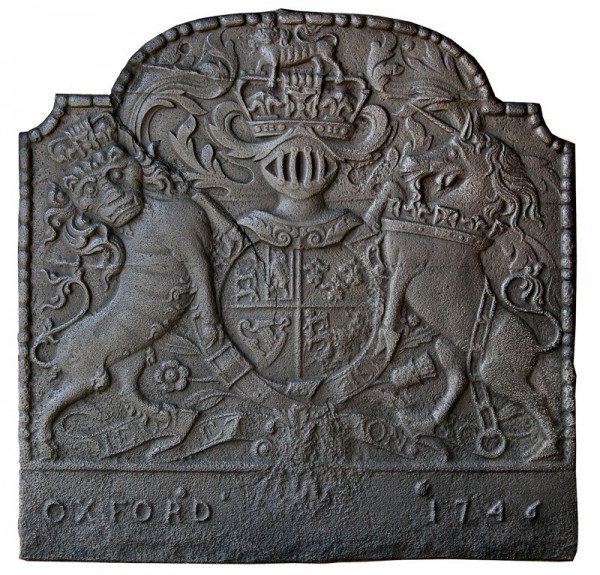
Chimney back, Oxford Furnace, Warren County, New Jersey, 1746. Cast iron. 34 1/4" x 34". (Private collection; photo, Vince Cassaro.)

Frieze appliqué in the Assembly Room of the Pennsylvania State House. (Historic American Building Survey, Library of Congress.)

Frieze appliqué attributed to Samuel Harding in the stair tower of the Pennsylvania State House, Philadelphia, Pennsylvania, 1753–1756. (Courtesy, Independence Hall National Historic Site; photo, Gavin Ashworth.)

Desk-and-bookcase with carving attributed to the shop of Samuel Harding, Philadelphia, Pennsylvania, 1750–1755. Walnut with tulip poplar, yellow pine, and white cedar. H. 112", W. 40 3/4", D. 23 3/4". (Chipstone Foundation; photo, Gavin Ashworth.)

Detail of the tympanum appliqué on the desk-and-bookcase illustrated in fig. 26. (Photo, Gavin Ashworth.) The appliqués on either side of the shell are so undercut that they make little contact with the tympanum and appear to float over it.
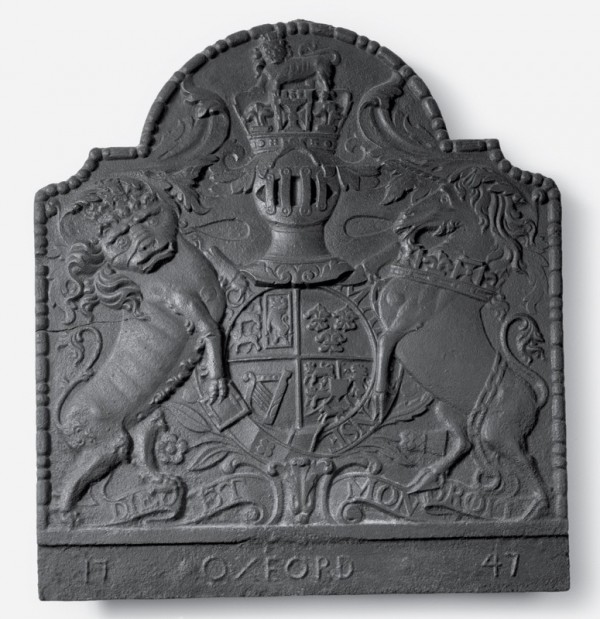
Chimney back, Oxford Furnace, Warren County, New Jersey, 1747. Cast iron. 32 1/4" x 29 1/4". (Courtesy, Winterthur Museum.)

Exterior truss on the steeple of Christ Church, Philadelphia, 1753. (Historic American Building Survey, Library of Congress.)
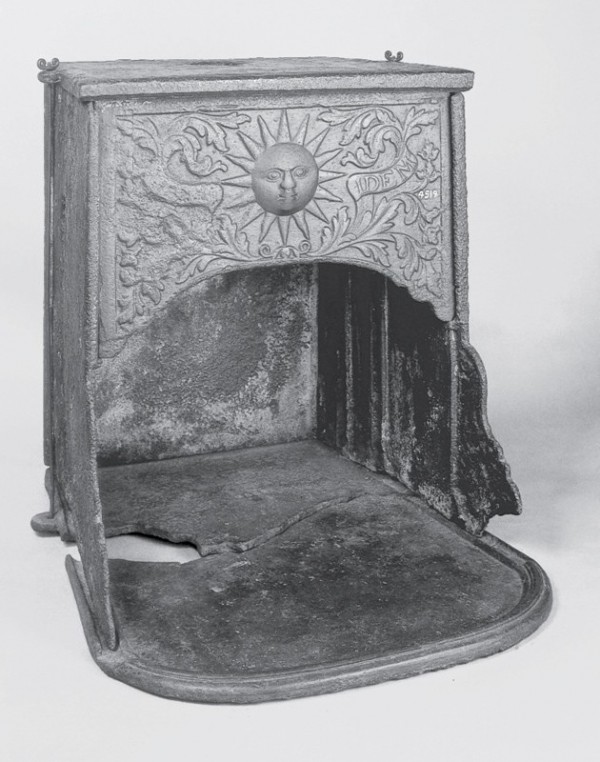
Franklin stove attributed to Warwick or Mount Pleasant Furnace, Chester or Berks County, Pennsylvania, ca. 1742–1748. Cast iron. H. 31 1/2", W. 27 1/2", D. 35 3/4". (Courtesy, Mercer Museum of the Bucks County Historical Society; photo, Philadelphia Museum of Art.)

James Turner (act. 1744–1759) after Lewis Evans, design for Franklin’s Stove, illustrated in An Account of the New Invented Pennsylvanian Fire-places. (Courtesy, Library Company of Philadelphia.)
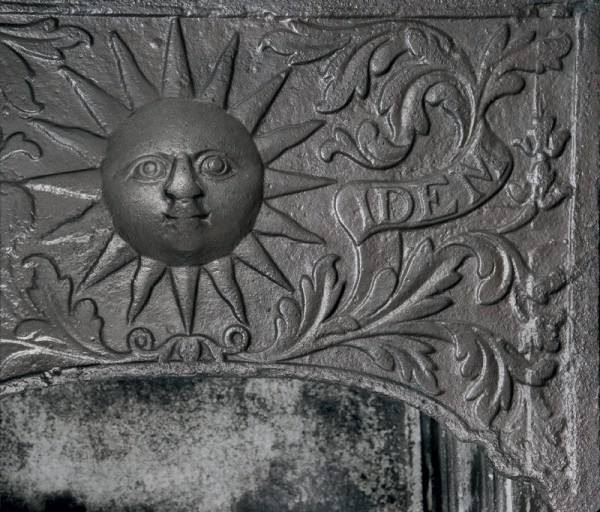
Detail of the front plate of the stove illustrated in fig. 30.

Details of the frieze appliqué illustrated in fig. 24.

Tea table, Philadelphia, Pennsylvania, 1745–1755. Mahogany. H. 27 1/2", W. 34 5/8", D. 21 1/8". (Courtesy, Winterthur Museum.)
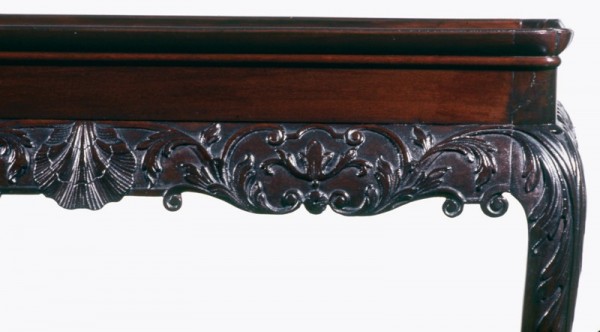
Detail of the carving on a side rail of the tea table illustrated in fig. 34.
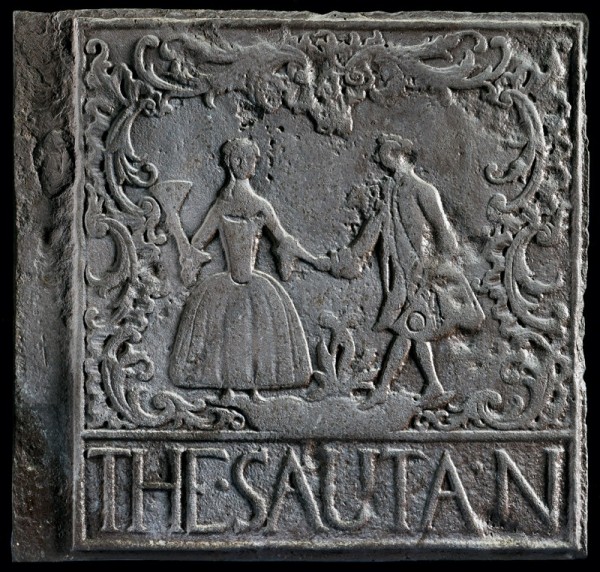
Side plate of a jamb stove, New Jersey or Pennsylvania, 1760. Cast iron. H. 22 1/2", W. 23 1/2". (Courtesy, Mercer Museum of the Bucks County Historical Society; photo, Gavin Ashworth.)

End plate of a jamb stove, New Jersey or Pennsylvania, 1760. Cast iron. H. 221/4", W. 18 1/4". (Henry C. Mercer, The Bible in Iron: Pictured Stoves and Stoveplates of the Pennsylvania Germans [1914; revised, corrected, and enlarged by Horace C. Mann, Doylestown, Pa.: Bucks County Historical Society, 1914], no. 88-c.)

Side chair, Philadelphia, Pennsylvania, ca. 1765. Mahogany. H. 41 1/8", W. 23 3/4", D. 21 3/4". (Chipstone Foundation; photo, Gavin Ashworth.)

Detail of the side plate illustrated in fig. 36. (Photo, Gavin Ashworth.)
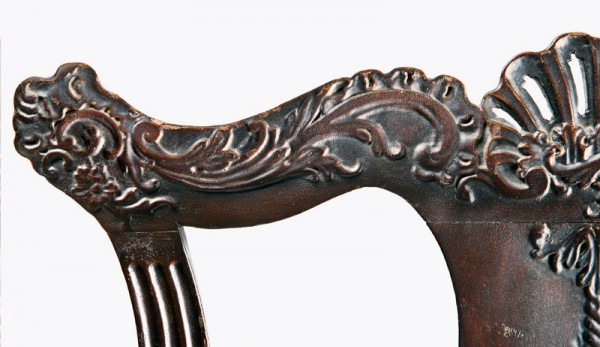
Detail of the crest rail of the side chair illustrated in fig. 38. (Photo, Gavin Ashworth.)
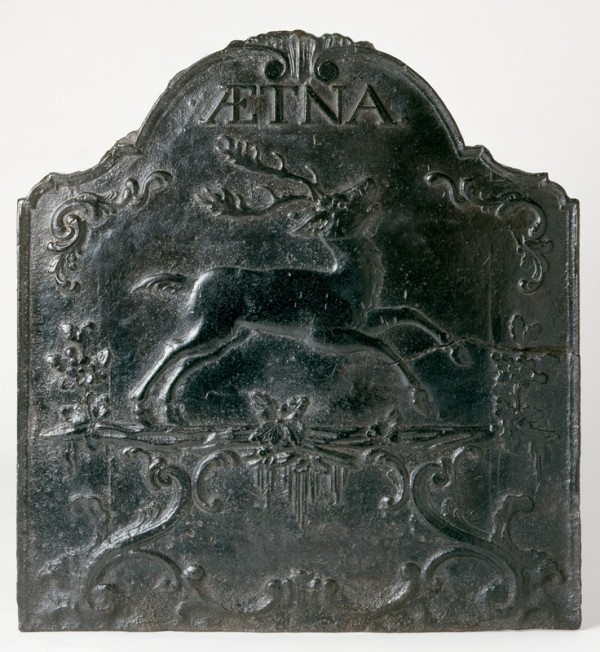
Chimney back, Aetna Furnace, Burlington County, New Jersey, 1767–1775. Cast iron. H. 26 1/4", W. 22 1/8". (Courtesy, Winterthur Museum.)

Chimney back, Aetna Furnace, Burlington County, New Jersey, 1767–1775. Cast iron. H. 31", W. 29 1/4". (Courtesy, Winterthur Museum.)

Pier glass attributed to the shop of James Reynolds, Philadelphia, Pennsylvania, 1766–1775. White pine. 48" x 26". (Courtesy, Metropolitan Museum of Art.)

Pattern for a six- or ten-plate stove attributed to the shop of James Reynolds, Philadelphia, Pennsylvania, 1775–1790. Mahogany. Dimensions not recorded. (Private collection.)

Detail of the carving on the pattern illustrated in fig. 44.

Detail of the carving in the upper left corner of a parcel gilt pier glass made by James Reynolds for John and Elizabeth (Lloyd) Cadwalader in 1771. (Courtesy, Winterthur Museum.)
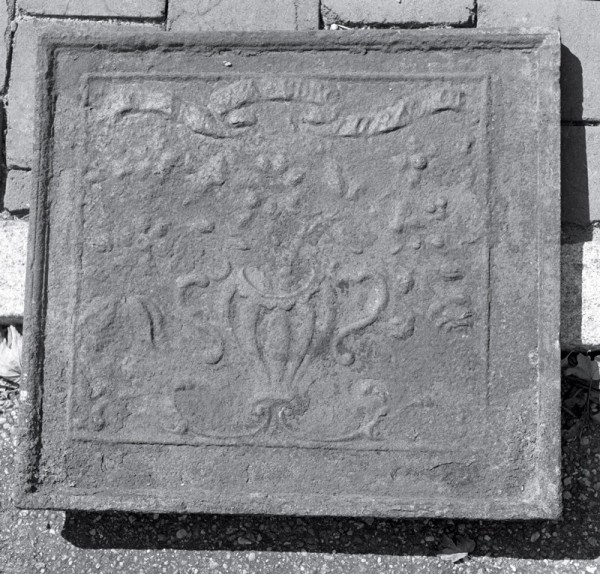
Chimney back, Marlboro Furnace, Frederick County, Virginia, 1770–1775. Cast iron. Dimensions not recorded. (Courtesy, Museum of Early Southern Decorative Arts.) The pattern that produced this chimney back was also used to cast stove plates like the example illustrated in fig. 48.

Side plate from a six-plate stove, Marlboro Furnace, Frederick County, Virginia, 1770–1775. Cast iron. 24" x 26". (Courtesy, Museum of Early Southern Decorative Arts.) The pattern that produced this side plate was also used to cast chimney backs like the example illustrated in fig. 47.

Truss attributed to Bernard and Jugiez, Philadelphia, Pennsylvania, 1769. (Courtesy, Metropolitan Museum of Art; photo, Luke Beckerdite.) This truss is on a chimneypiece from the Samuel Powel House installed in the American Wing of the Metropolitan Museum of Art.
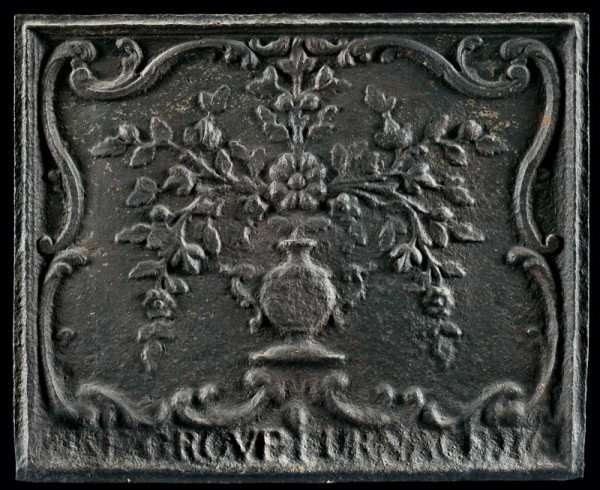
Side plate from a six-plate stove, Pottsgrove Furnace, Montgomery County, Pennsylvania, ca. 1770. Cast iron. 19 1/4" x 23 1/4". (Courtesy, Mercer Museum of the Bucks County Historical Society; photo, Gavin Ashworth.)
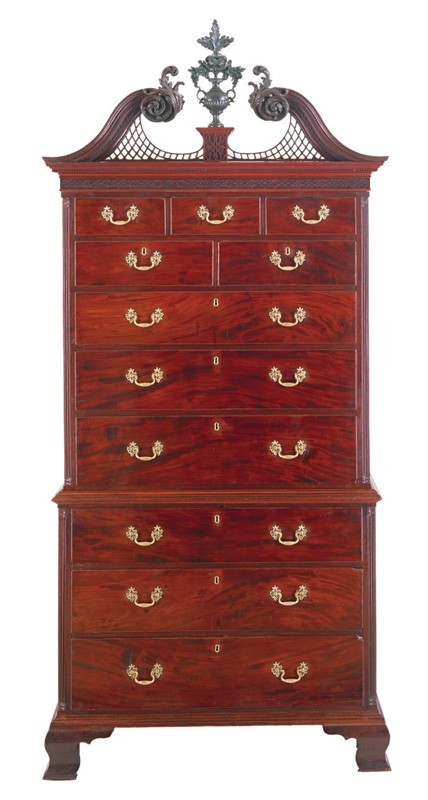
Thomas Affleck, chest-on-chest , Philadelphia, Pennsylvania, ca. 1770. Mahogany with tulip poplar and white cedar. H. 101", W. 46 3/8", D. 24". (Courtesy, Colonial Williamsburg Foundation; acquired through the generosity of Mr. and Mrs. Lewis B. Rumford II.)
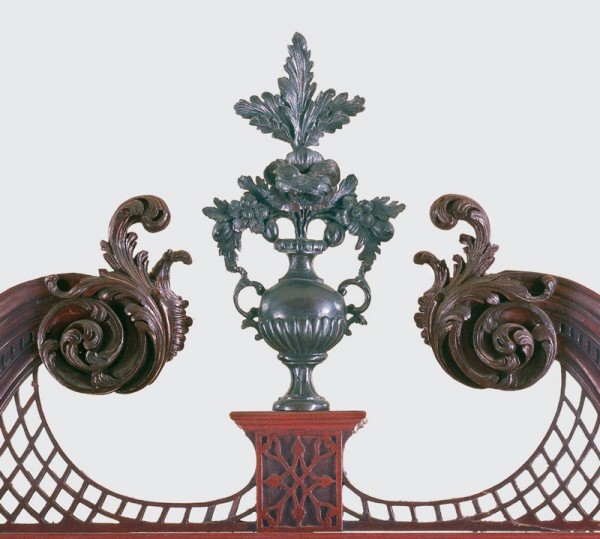
Detail of the ornament of the chest-on-chest illustrated in fig. 51.
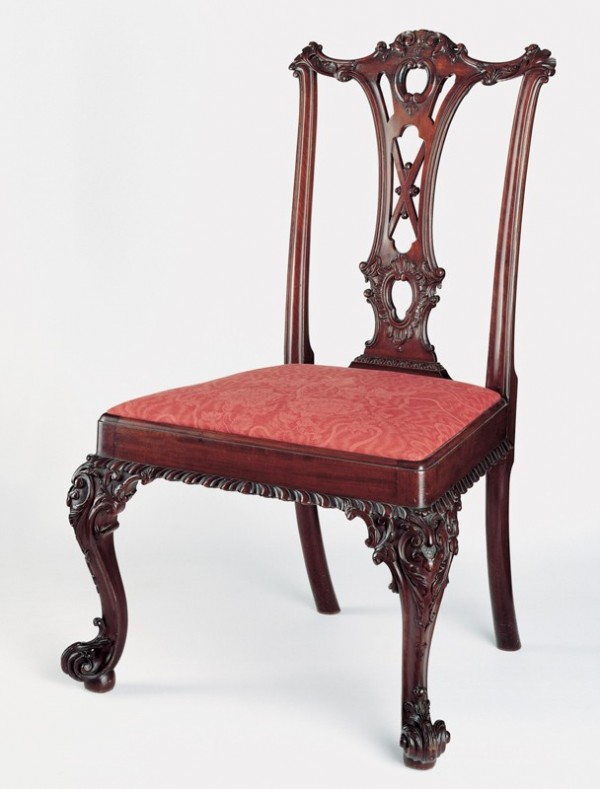
Side chair with carving attributed to Martin Jugiez, Philadelphia, Pennsylvania, ca. 1765. Mahogany. H. 39 1/2", W. 25 1/2", D. 23 1/2". (Chipstone Foundation; photo, Gavin Ashworth.)
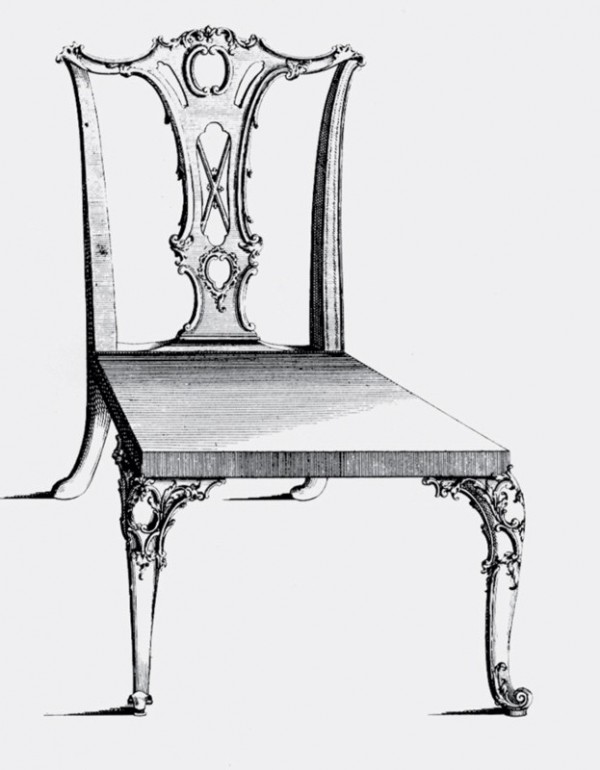
Design for a side chair shown on pl. 12 of the first and second editions of Thomas Chippendale’s The Gentleman and Cabinet-Maker’s Director (1754, 1755). (Courtesy, Winterthur Library.) This design appeared on pl. 14 in the third edition (1762).

Side plate from a six-plate stove, Batsto Furnace, Burlington County, New Jersey, 1766–1775. Cast iron. 19 3/4" x 22". (Henry C. Mercer, The Bible in Iron: Pictured Stoves and Stoveplates of the Pennsylvania Germans [Doylestown, Pa.: Bucks County Historical Society, 1914], no. 173.)

High chest of drawers with carving attributed to Bernard and Jugiez, Philadelphia, Pennsylvania, 1770–1775. Mahogany with yellow pine, tulip poplar, and white cedar. H. 96 3/4", W. 45 1/2", D. 24 1/2". (Courtesy, Philadelphia Museum of Art; photo, Graydon Wood.)
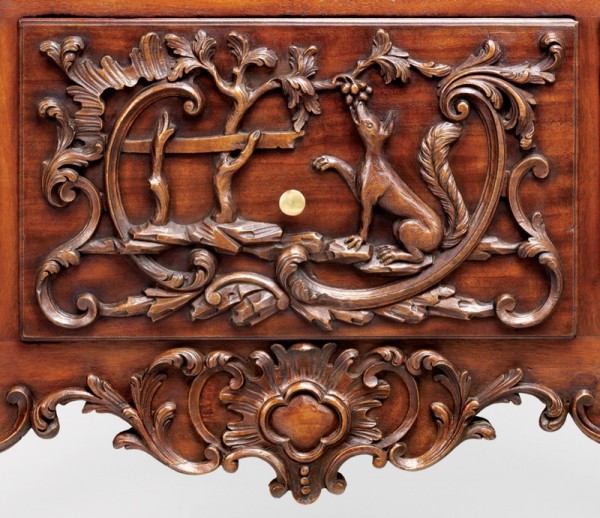
Detail of the appliqué on the center drawer of the lower case of the high chest illustrated in fig. 56.
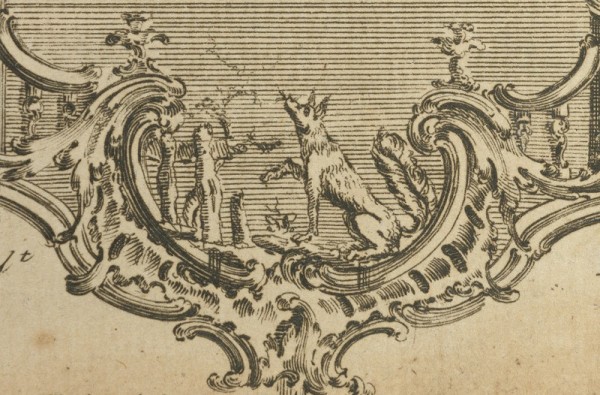
Detail of a design for a pier glass illustrated on pl. 21 in Thomas Johnson’s One Hundred Fifty New Designs (collected editions, 1758 [untitled] and 1761 [titled]). (Courtesy, Winterthur Library; Printed Book and Periodical Collection.) Johnson sold the designs incrementally in groups between 1756 and 1757. (Jacob Simon, “Thomas Johnson’s ‘The Life of the Author,’” Furniture History 39 [2003]: 10.)

James Kirk (etcher) after Francis Barlow, The Dog and Piece of Flesh, published by Robert Sayer, London, ca. 1760. (Courtesy, © Trustees of the British Museum.)
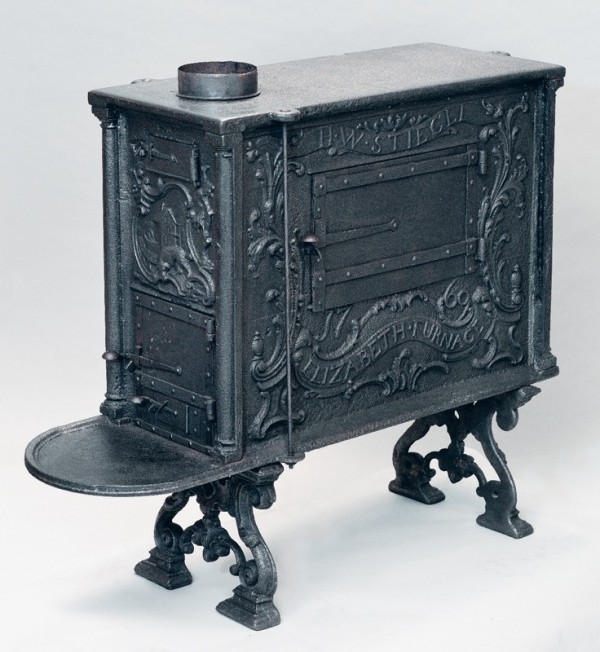
Ten-plate stove, Elizabeth Furnace, Lancaster County, Pennsylvania, ca. 1769. Cast iron. H. 63 1/4", W. 44 1/4", D. 15". (Courtesy, Hershey Museum.)
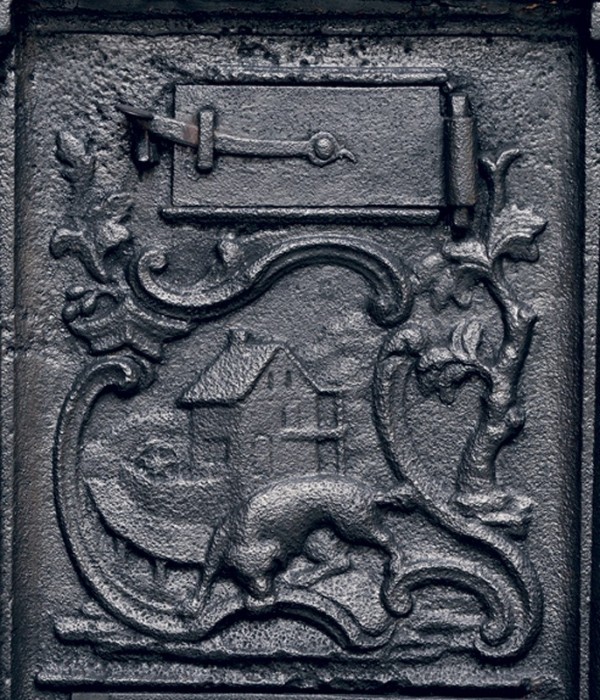
Detail of the front plate of the stove illustrated in fig. 60.
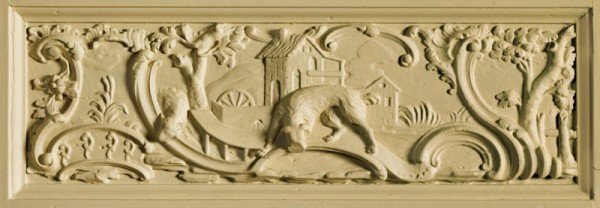
Detail of the center tablet on a chimneypiece from the Samuel Powel House, Philadelphia, Pennsylvania, 1770. (Courtesy, Philadelphia Museum of Art, gift of Mr. and Mrs. George D. Windner, 1926.)

Side plate from a six-plate stove, Elizabeth Furnace, Lancaster County, Pennsylvania, ca. 1769. Cast iron. 23" x 25". (Courtesy, Mercer Museum of the Bucks County Historical Society; photo, Gavin Ashworth.)
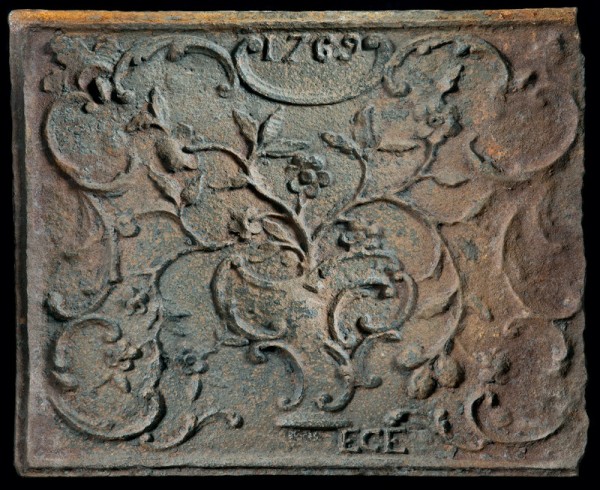
Side plate from a six-plate stove, Elizabeth Furnace, Lancaster County, Pennsylvania, ca. 1769. Cast iron. Original dimensions, 18 1/2" x 23". (Courtesy, Historical Society of Berks County Museum & Library; photo, Gavin Ashworth.)

Side plate from a six- or ten-plate stove, Reading Furnace, Chester County, Pennsylvania, ca. 1772. Cast iron. 23" x 30". (Courtesy, State Museum of Pennsylvania, Pennsylvania Historical and Museum Commission.)
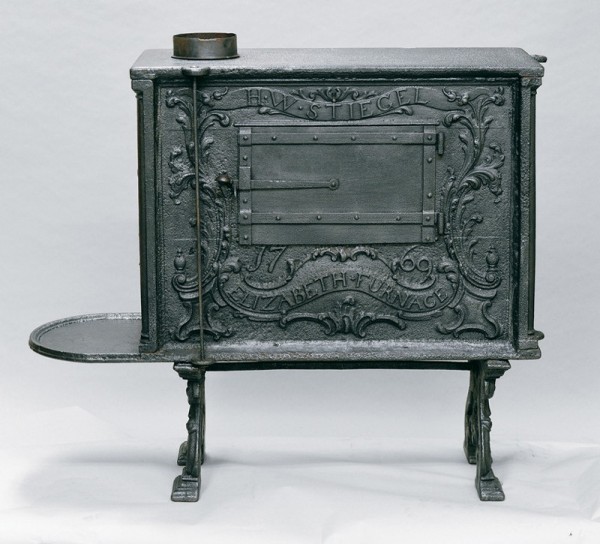
Side view of the stove illustrated in fig. 60.
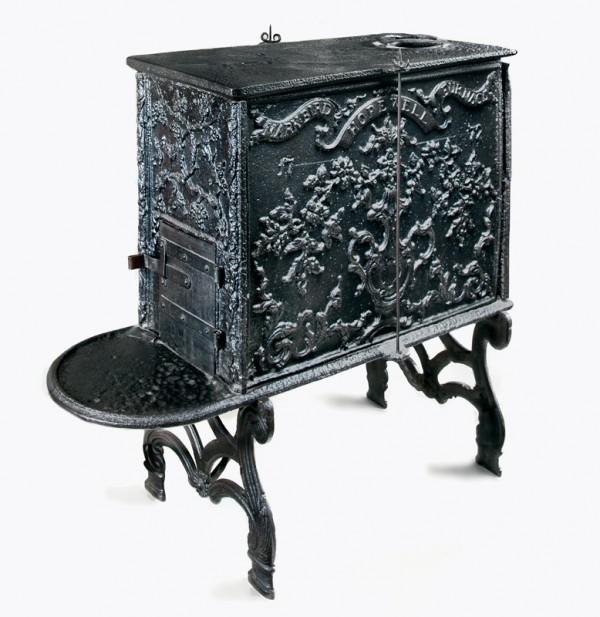
Six-plate stove, Hopewell Furnace, Berks County, Pennsylvania, ca. 1772. Cast iron. H. 35", W. 41", D. 18". (Courtesy, Hopewell National Historic Site; photo, Gavin Ashworth.)
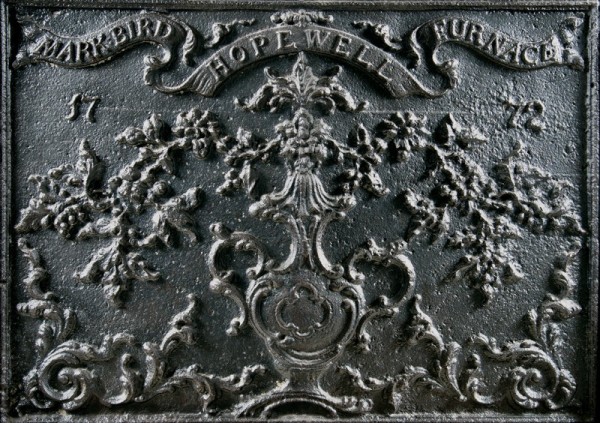
Detail of a side plate of the stove illustrated in fig. 67. (Photo, Gavin Ashworth.)
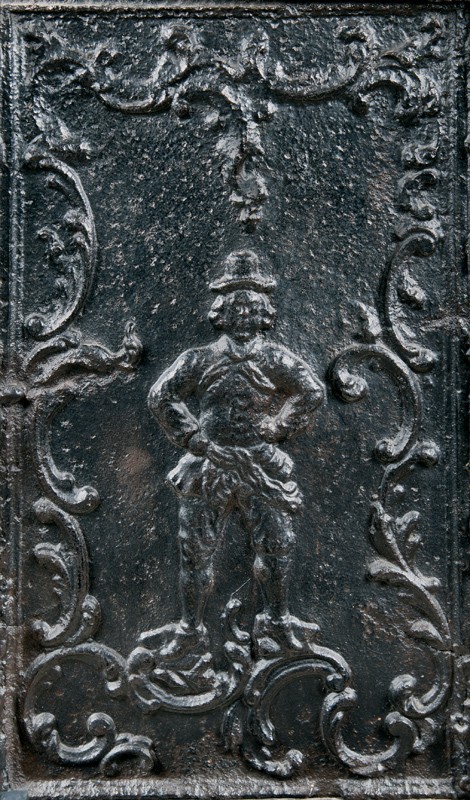
Detail of the back plate of the stove illustrated in fig. 67. (Photo, Gavin Ashworth.)
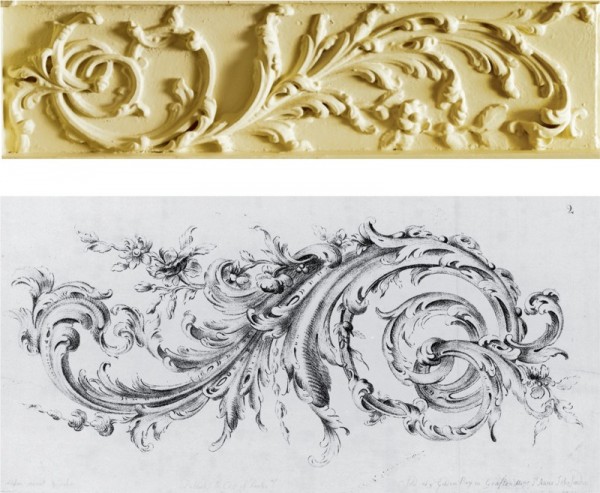
Details showing a frieze appliqué on a chimneypiece from the Thomas Ringgold House, Chestertown, Maryland, and a design for a frieze illustrated on pl. 2 in Thomas Johnson, A New Book of Ornaments (1762). (Courtesy, Baltimore Museum of Art; photos, Gavin Ashworth [appliqué] and Victoria & Albert Museum [design].)

Pier table attributed to the shop of Benjamin Randolph with carving attributed to John Pollard, Philadelphia, Pennsylvania, ca. 1769. Mahogany with yellow pine. H. 32 3/8", W. 48", D. 23 1/4". (Courtesy, Metropolitan Museum of Art; photo, Gavin Ashworth.)
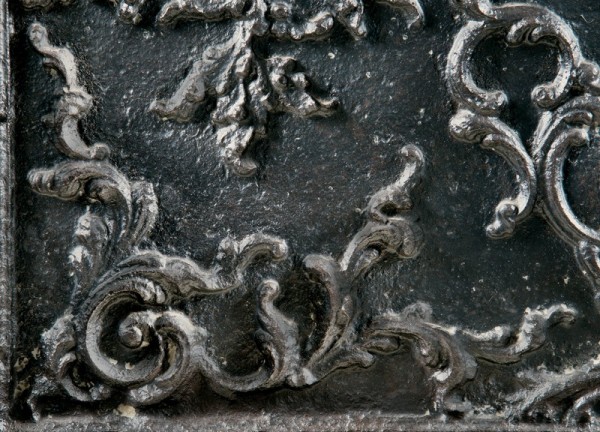
Detail of the side plate illustrated in fig. 68. (Photo, Gavin Ashworth.)
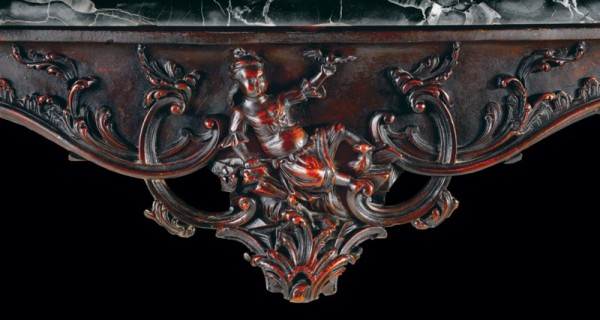
Detail of the carving on the front rail of the pier table illustrated in fig. 71. (Photo, Gavin Ashworth.)
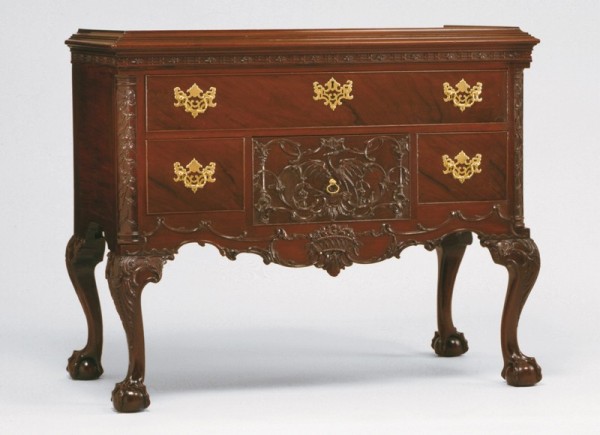
Base of a high chest of drawers with carving attributed to the shop of John Pollard, Philadelphia, Pennsylvania, ca. 1775. Mahogany with yellow pine and white cedar. H. 38", W. 45 5/8", D. 22 13/16". (Courtesy, Diplomatic Reception Rooms, U.S. Department of State.)

Detail of the appliqué on the bottom center drawer of the high chest base illustrated in fig. 74.

Side plate from a six- or ten-plate stove, Durham Furnace, Bucks County, Pennsylvania, ca. 1780. Cast iron. 25" x 31 3/4". (Courtesy, Mercer Museum of the Bucks County Historical Society; photo, Gavin Ashworth.)

Detail of the right frieze appliqué on a chimneypiece from a Philadelphia town house installed in the Winterthur Museum, ca. 1770. (Courtesy, Winterthur Museum.) The frieze appliqués are attributed to John Pollard.
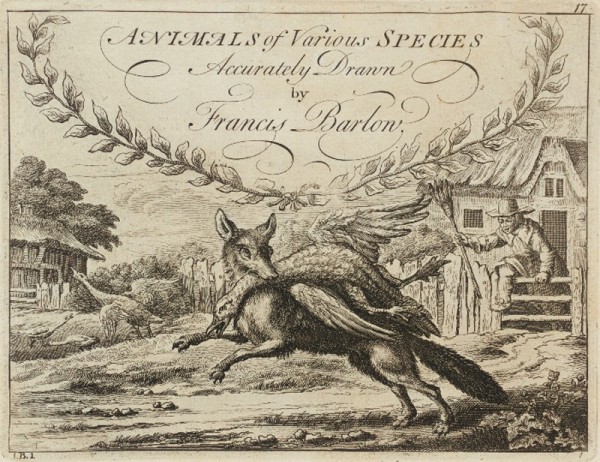
Title page of Animals of Various Species Accurately Drawn by Francis Barlow, part three of Various Birds and Beasts Drawn from Life (London, ca. 1660–1670). (Courtesy, © Tate Museum. CC-BY-NC-ND 3.0)

Pattern fragment, probably Durham Furnace, Bucks County, Pennsylvania, 1775–1780. (Courtesy, Museum of Early Southern Decorative Arts.)

Side plate from a six-plate stove, possibly Durham Furnace, Bucks County, Pennsylvania, or Marlboro Furnace, Frederick County, Virginia, 1775–1780. Cast iron. 22" x 27 1/4". (Courtesy, Colonial Williamsburg Foundation, gift of Wallace and Liza Gusler.)
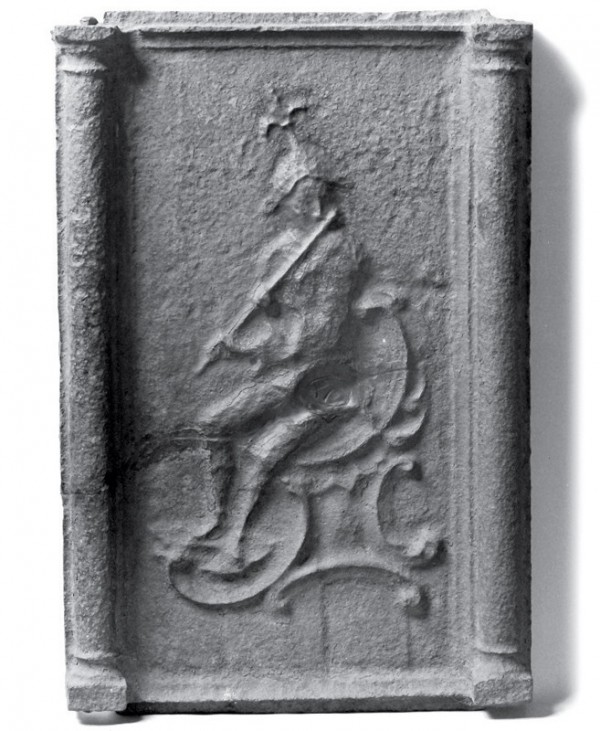
End plate from a stove, possibly Durham Furnace, Bucks County, Pennsylvania, or Marlboro Furnace, Frederick County, Virginia, 1775–1780. Cast iron. 21 3/4" x 14 3/8". (Courtesy, Museum of Early Southern Decorative Arts.)
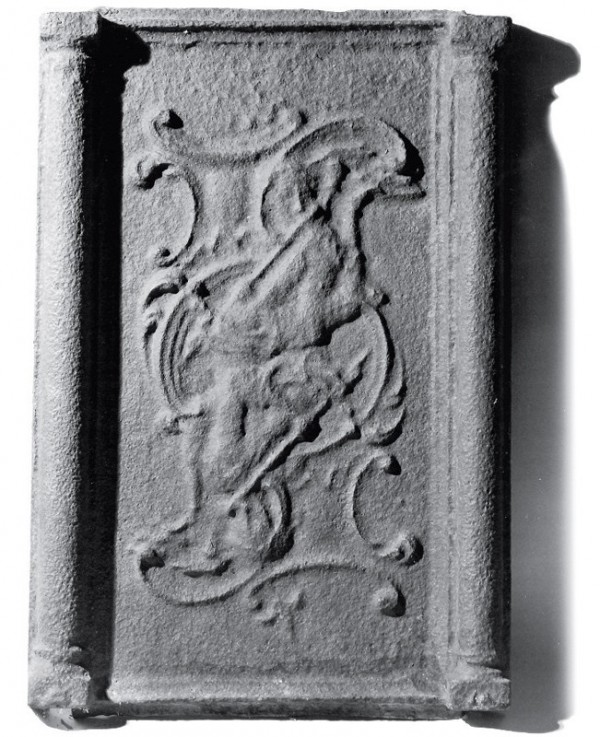
End plate from a stove, possibly Durham Furnace, Bucks County, Pennsylvania, or Marlboro Furnace, Frederick County, Virginia, 1775–1780. Cast iron. 21 3/4" x 14 1/8". (Courtesy, Museum of Early Southern Decorative Arts.)

End plate from a stove, possibly Durham Furnace, Bucks County, Pennsylvania, or Marlboro Furnace, Frederick County, Virginia, 1775–1780. Cast iron. 23 3/4" x 14". (Courtesy, Mercer Museum of the Bucks County Historical Society; photo, Gavin Ashworth.)

Design for a chimneypiece illustrated on pl. 7 in Matthias Lock and Henry Copland, A New Book of Ornaments (1752). (Courtesy, Winterthur Library; Printed Book and Periodical Collection.)
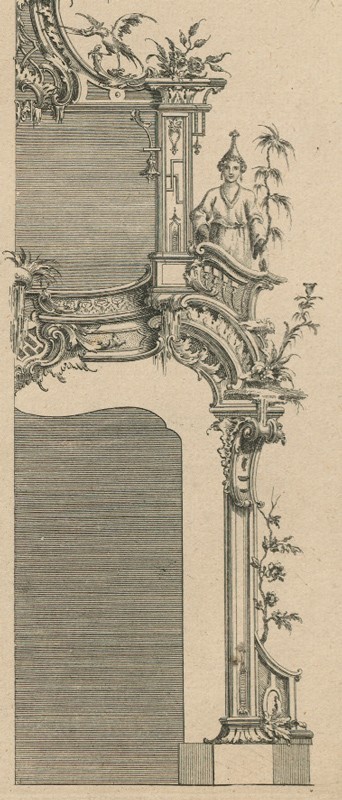
Design for a chimneypiece illustrated on pl. 4 in Matthias Lock and Henry Copland, A New Book of Ornaments (1752). (Courtesy, Winterthur Library; Printed Book and Periodical Collection.)
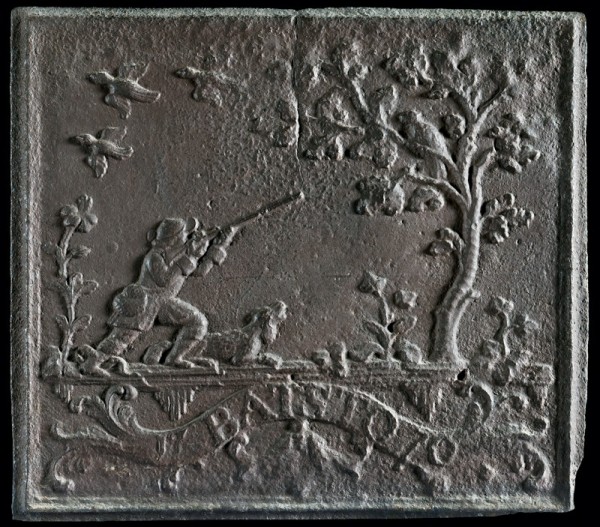
Side plate from a six-plate stove, Batsto Furnace, Burlington County, New Jersey, ca. 1772. Cast iron. 23" x 25 1/2". (Courtesy, Mercer Museum of the Bucks County Historical Society; photo, Gavin Ashworth.)
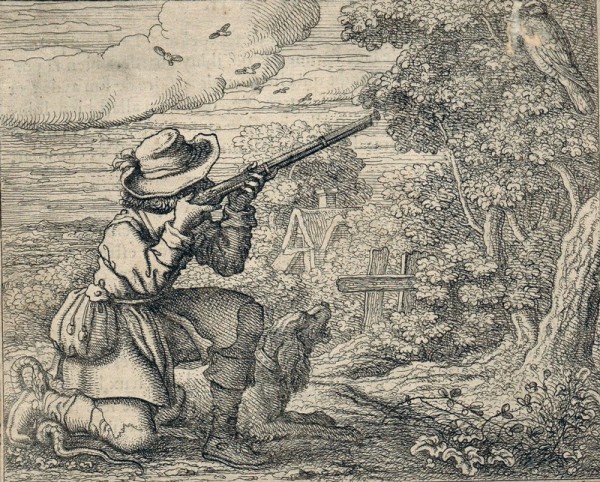
Francis Barlow, “The Fowler and the Ringdove,” London, ca. 1687.

Side chair with carving attributed to John Pollard, Philadelphia, Pennsylvania, ca. 1770. Mahogany with yellow pine. H. 38 1/2". (Private collection; photo, Gavin Ashworth.)

Detail of the carving on the crest and left stile of the side chair illustrated in fig. 88. (Photo, Gavin Ashworth.)
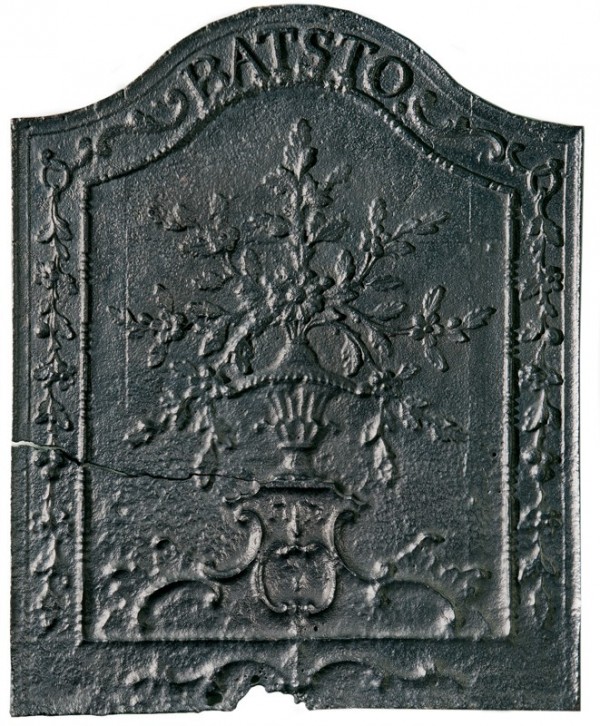
Chimney back, Batsto Furnace, Burlington County, New Jersey, 1770–1775. Cast iron. 26 1/4" x 22 1/4". (Courtesy, New Jersey State Museum; photo, Gavin Ashworth.)
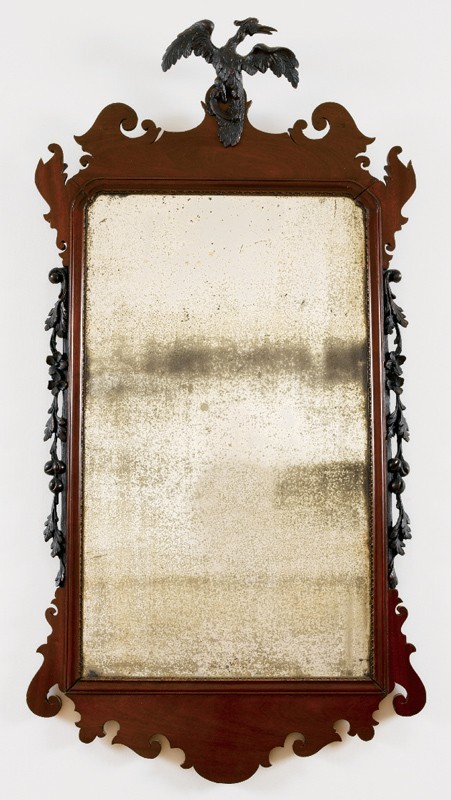
Looking glass with carving attributed to the shop of John Pollard, Philadelphia, Pennsylvania, 1770–1780. Mahogany with white pine. Dimensions not recorded. (Private collection; photo, Gavin Ashworth.)
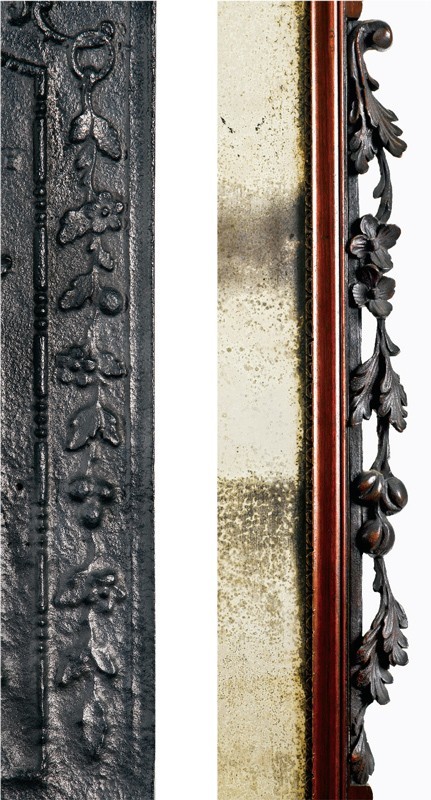
Detail of the left garland on the chimney back illustrated in fig. 90 and the left garland on the looking glass illustrated in fig. 91. (Photos, Gavin Ashworth.)
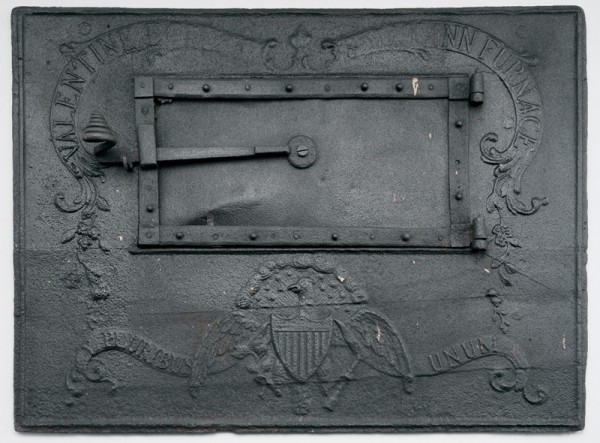
Side plate from a ten-plate stove, Sally Ann Furnace, Bucks County, Pennsylvania, ca. 1795. Cast iron. 26" x 35". (Courtesy, Metropolitan Museum of Art, purchase, Dobson Foundation, Inc., gift.)
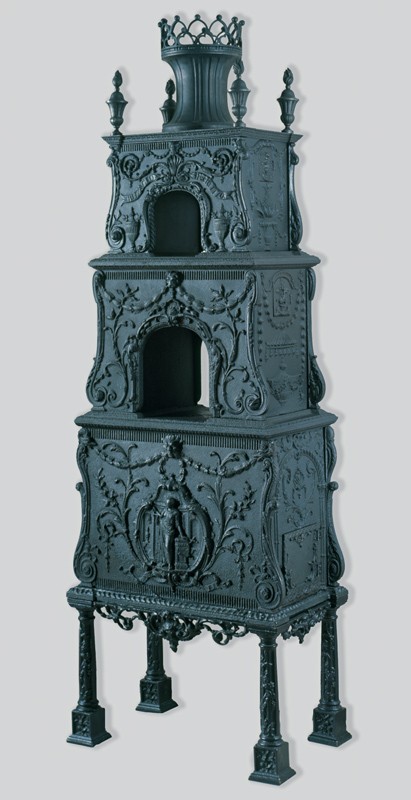
Abraham Buzaglo, stove, London, 1770. Cast iron. H. 88 1/2", W. 35 1/8", D. 21 11/16". (The Commonwealth of Virginia on loan to the Colonial Williamsburg Foundation; photo, Colonial Williamsburg Foundation.)
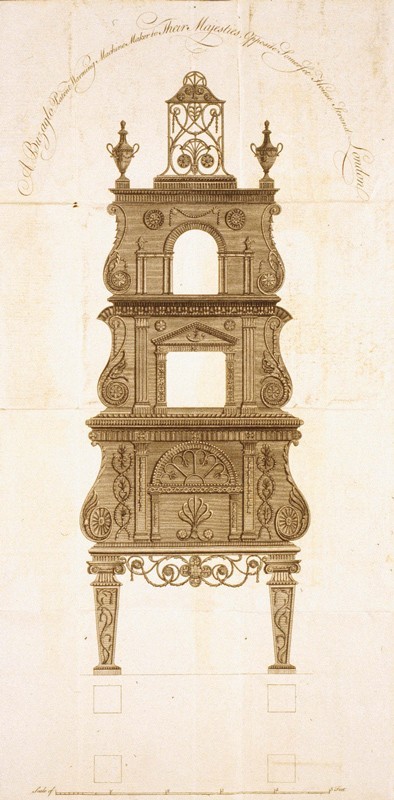
A Buzaglo, Patent Warming Machine Maker to Their Majesties, Opposite Somerset House Strand, London, ca. 1770. Black and white line engraving. (Courtesy, Colonial Williamsburg Foundation; gift of Reverend Richard Webster Meyers, 1992-145.)

Tall case clock, Philadelphia, 1775–1785. Mahogany with tulip poplar. Dimensions not recorded. (Courtesy, Philip Bradley Antiques.)
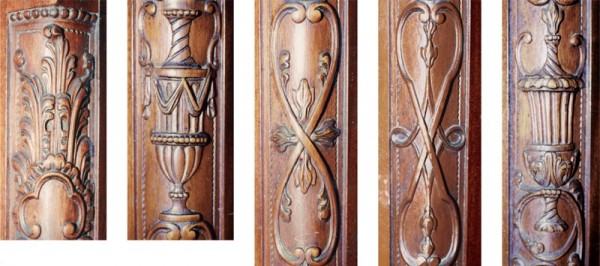
Details of the carving on a quarter-column of the tall case clock illustrated in fig. 96.
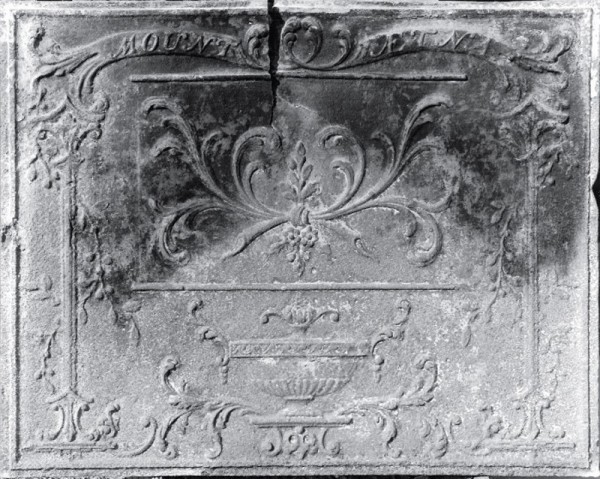
Side plate from a six- or ten-plate stove, Mount Aetna Furnace, Washington County, Maryland, 1775–1785. Cast iron. Dimensions not recorded. (Courtesy, Museum of Early Southern Decorative Arts.)

Six-plate stove, Batsto Furnace, Burlington County, New Jersey, 1780–1790. Cast iron. Dimensions not recorded. (Courtesy, New Jersey Department of Environmental Protection, State Park Service, Batsto Village; photo, Gavin Ashworth.)
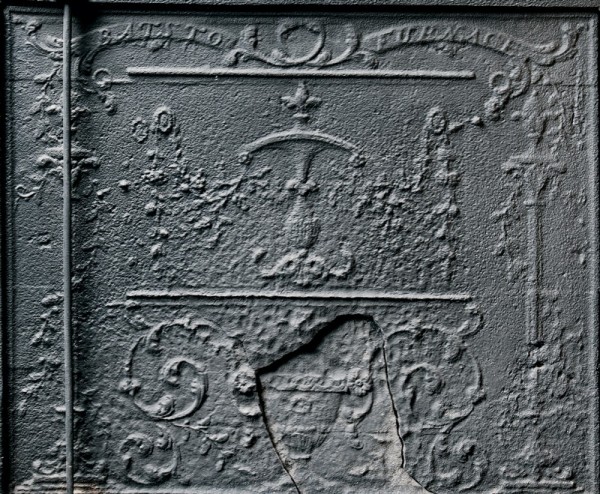
Detail of a side plate of the stove illustrated in fig. 99. (Photo, Gavin Ashworth.)
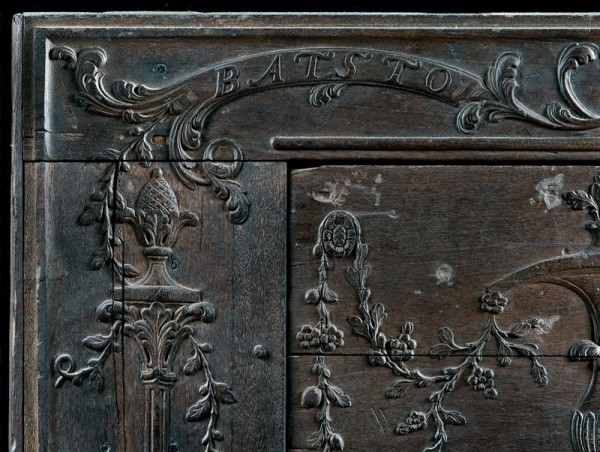
Detail of the carving on the pattern illustrated in fig. 1. (Photo, Gavin Ashworth.)
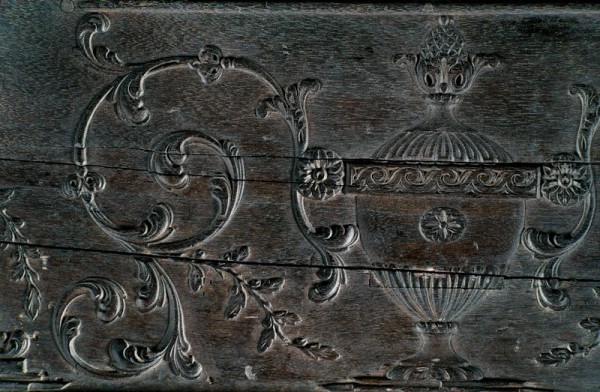
Detail of the carving on the pattern illustrated in fig. 1. (Photo, Gavin Ashworth.)

Detail of the carving on the pattern illustrated in fig. 1. (Photo, Gavin Ashworth.)
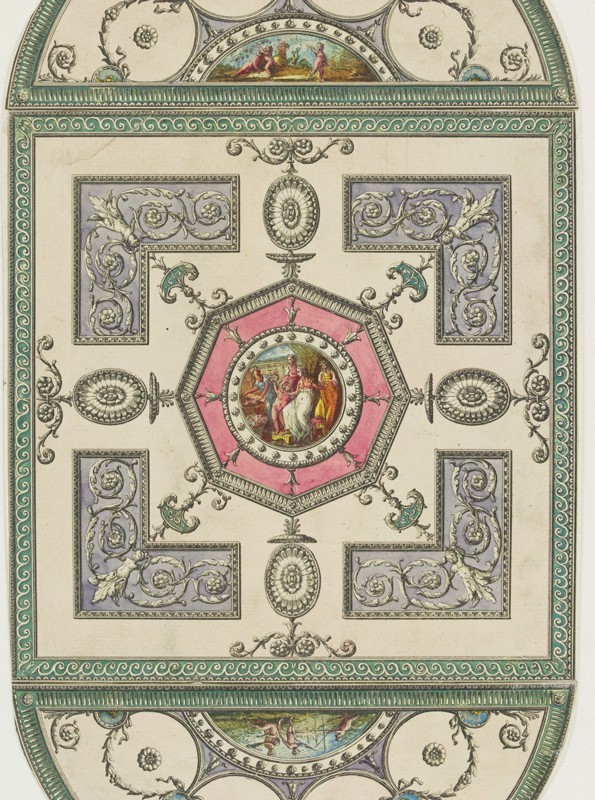
Ceiling design by Robert Adam, 1769. (Courtesy, Victoria & Albert Museum.)
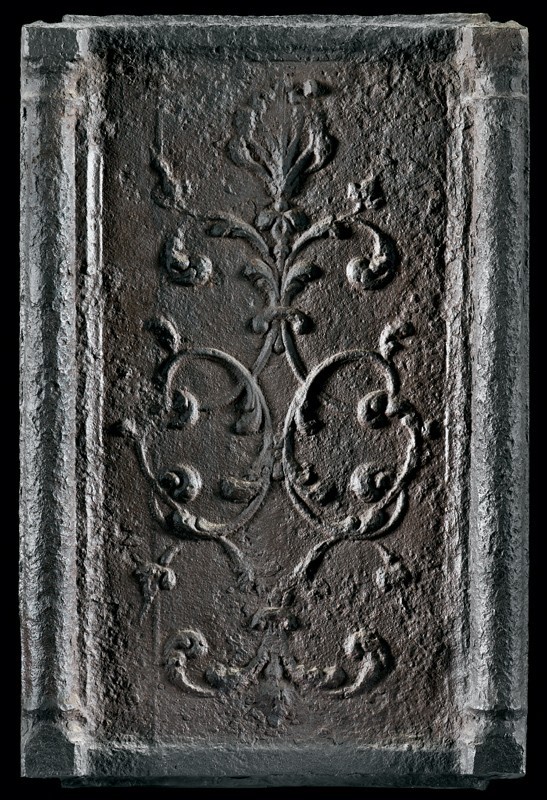
Side plate from a six-plate stove, probably Berkshire Furnace, Berkshire County, Pennsylvania, ca. 1782. Cast iron. 16 1/2" x 24". (Courtesy, Mercer Museum of the Bucks County Historical Society; photo, Gavin Ashworth.) The stove represented by this side plate may have had an end plate like the example illustrated in fig. 106.
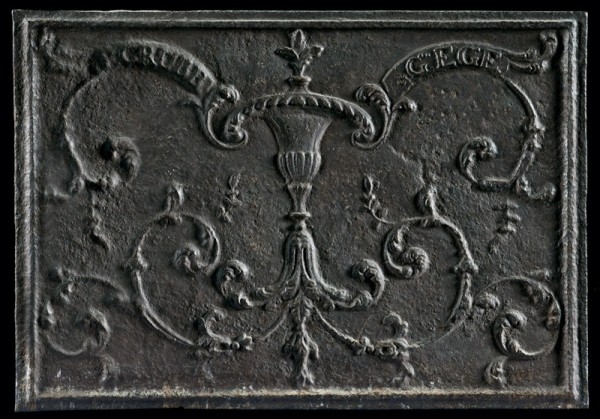
End plate from a stove, probably Berkshire Furnace, Berkshire County, Pennsylvania, ca. 1782. Cast iron. 22 1/2" x 15". (Courtesy, Mercer Museum of the Bucks County Historical Society; photo, Gavin Ashworth.) The stove represented by this end plate may have had side plates like the example illustrated in fig. 105.

Side plate from a six- or ten-plate stove, Berkshire Furnace, Berks County, Pennsylvania, 1780–1790. Cast iron. 22 1/2" x 32 1/4". (Courtesy, Winterthur Museum.) The stove represented by this side plate had an end plate like the example illustrated in fig. 108.

End plate from a six-plate stove, Berkshire Furnace, Berks County, Pennsylvania, 1780–1790. Cast iron. 25" x 15 1/2". (Courtesy, Mercer Museum of the Bucks County Historical Society, photo, Gavin Ashworth.) The stove represented by this end plate had side plates like the example illustrated in fig. 107.

Tall case clock, Philadelphia, 1770–1780. Sabieu with tulip poplar. H. 104". (Courtesy, Philip Bradley Antiques.)

Detail of the hood of the tall case clock illustrated in fig. 109.
